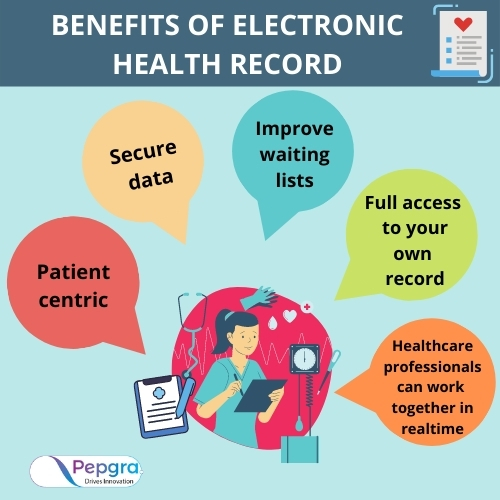Brief:
- Advancements in the medical field and the proliferation of diagnosis and screening tests have to create mountains of data on patient healthcare. Digital information technology has seemed poised to revolutionize health care in the world.
- Still, many physicians have come to hate their computers. Overwhelmed by administrative work, they now spend more time attending to data entry than they do interact with the patients.
- The electronic health records have the panacea to efficiency for the healthcare sectors is explained in this Pepgra blog.
Introducing electronic health records (EHR):
An electronic health record is digital data information about a patient’s paper chart in a Clinical research organization. The EHRs are real-time, patient-centered records that will make information available immediately with high safety to authorized users. EHR does contain the medical and therapeutic histories of patients, and it is built to go beyond clinical data collection in a provider’s office and can be inclusive of a broader view of a patient’s health care. EHRs are a vital part of the healthcare IT sectors. It contains a patient’s medical history, diagnoses, medications dosages, therapeutic plans, immunization, radiology images, allergies, and laboratory test results for Clinical trial Monitoring Services.
One of the most significant advantages of EHR is creating and managing healthcare information to the providers in a digital version capable of being shared with other professionals across more than one health care sectors. EHRs share information with other health care providers and organizations such as clinical laboratories, specialists, pharmacies, medical imaging facilities, emergency facilities, and workplace clinics – so they contain information from all clinicians involved in a patient’s health.

Benefits of EHRs:
Radically our world’s transformation achieved by digital technology like usage of smartphones, web-enabled devices, and tablets transformed the daily lives of everyday people and the way we communicate.
A significant and more seamless flow of information within the healthcare data analysis in digital health care sector, using electronic health records encompasses digital progress and transform the way health care is delivered and compensated in clinical research by Clinical Biostatistics services.
Using EHRs information their many benefits to the healthcare industries provides Healthcare Analytics Solutions by,
- Improvement in Patient Care
- Increasing Patient Participation
- Improving Care Coordination
- Improving Diagnostics & Patient Outcomes
- Practice Efficiencies
- Cost Saving
Advantages of EHRs
In healthcare analytics EHRs have the ability to exchange health data electronically, helps you provide higher quality information and safe care for patients creating tangible enhancements for your organization using pharmaceutical regulatory consulting services. The EHRs help professionals manage care for patients and provide adequate health care with:
- Accurate, up-to-date information about the patient’s care
- Quick access to patient data records with more coordinated, efficient care
- Sharing electronic information with the patients and other clinicians securely
- Helping the providers with more effectively diagnoses, reduce medical mistakes, and provide safety
- Patient and provider communication, as well as health care conveniences
- Safer, more reliable prescription
- Promote legible, complete documentation and streamlined coding and billing of documents
- Enhancement of privacy and security of patient’s data clinical study design
- Providers improve productivity and balance the work-life
- Professionals to improve efficiency and meet the business goals
- They are reducing costs through paperwork, safety, reduced duplication of testing, and improved healthcare.
Transformation in Health Care
Electronic Health Records takes the first step to transform healthcare data analytics. The significance of electronic health records supports better health care by improving all aspects of patient care, communication, including safety, patient-centeredness, education, efficiency, timeliness, and equity. Better healthcare by encouraging healthier lifestyles in the entire population, including, better nutrition, avoidance of behavioral risks, increased physical activity and broader use of preventative care. Better clinical decision making for providers by integrating patient information from multiple sources from various sectors in the clinical study protocol.
Differences between EMR AND EHR
Electronic medical records are a digital document of the paper charts in the clinician’s form. The EMR contains the medical and therapeutic history of the patients in one practice and has advantages over paper records.
- Track data over time
- Quickly identify which patients are due for preventive screenings or checkups
- Check how their patients are doing on specific parameters such as vaccinations blood pressure readings
- Monitor the overall quality of care within the practice
Electronic health records do all those things and more. EHRs focus on the health of the patient-going beyond standard clinical data collected in the clinician’s office and including a broader view on a patient’s healthcare.
- The information from the healthcare data analytics primary care tells the emergency department clinician about the patient’s allergy so that the right therapeutics clinical research will be given to the patient appropriately, even if they are unconscious.
- A patient can log on to his record and see the lab results over the last year, that can help to take his medications and keep up with the lifestyle changes
- The lab results are already in the record to tell the specialist what they need to know without running duplicate tests.
Conclusion:
However, to aid physicians with the medical diagnoses, healthcare data analytics solutions draw machine-learning techniques that will develop healthcare sectors. The digital medical assistant might be more capable than human works. Pepgra helps you to know about the EHRs in medical cases.
References:
- Blumenthal, D., & Tavenner, M. (2010). The “meaningful use” regulation for electronic health records. New England Journal of Medicine, 363(6), 501-504.
- Häyrinen, K., Saranto, K., & Nykänen, P. (2008). Definition, structure, content, use and impacts of electronic health records: a review of the research literature. International journal of medical informatics, 77(5), 291-304.
- Jha, A. K., Desroches, C. M., Campbell, E. G., Donelan, K., Rao, S. R., Ferris, T. G., … & Blumenthal, D. (2009). Use of electronic health records in US hospitals. New England Journal of Medicine, 360(16), 1628-1638.





